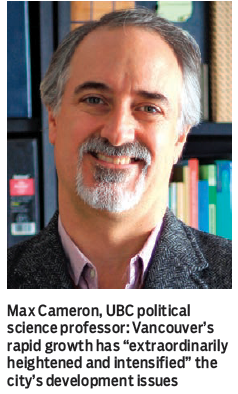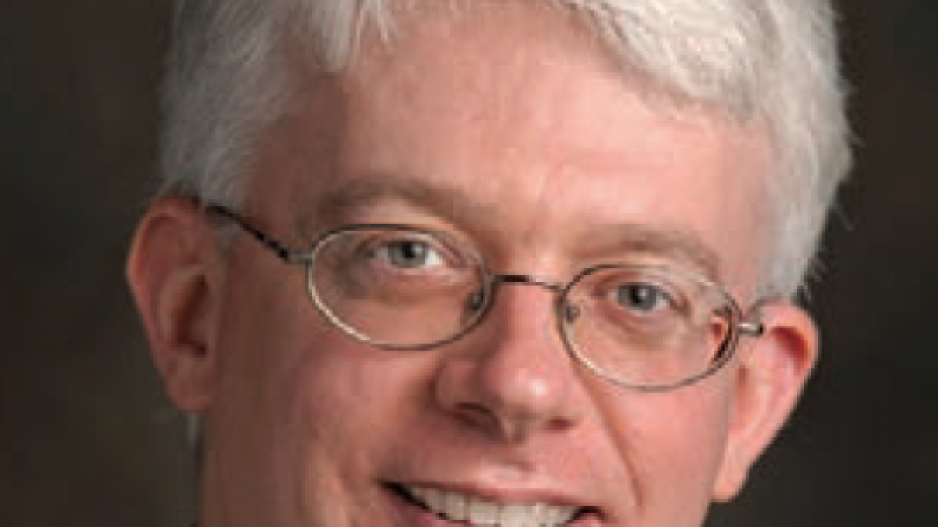This week’s burning question: unparty time or long-term Vision?
The answer in Vancouver in the last two civic elections: upstart Vision Vancouver, as the venerable Non-Partisan Association (NPA) – the party that’s not a party – squabbled over leadership in 2008 and continued to unravel in 2011.
The answer this time around is anyone’s guess, but as political observers note, Vision Vancouver’s civic political machinery continues to maintain momentum on the road to city hall dynasty status – though Vision Vancouver Mayor Gregor Robertson, in a recent Business in Vancouver editorial board interview, cautioned against using the “D word.”
The mayor preferred to point out that his incumbent Visionaries have been joined by “some great new blood … new candidates have come forward that bring some much-needed perspective on different parts of the city. The entire council is running again. I think that’s a good thing. It means things are stable, and it’ll be up to voters to decide.”
That it will, but how they decide and the political landscape upon which they will base their decisions in Vancouver is markedly different today from what it was when Vision took over 12th and Cambie in 2008 with Robertson beating NPA mayoral candidate Peter Ladner and Vision securing seven council seats. The Coalition of Progressive Electors (COPE) took another two. Suzanne Anton was the NPA’s sole city hall survivor.
The NPA did little to right the ship in the 2011 municipal election. Robertson handily defeated Anton, his NPA mayoral challenger. The NPA doubled its councillor count to two.
However, with former daily newspaperman Kirk LaPointe now at the helm vying for the mayor’s chair, the NPA is banking on its latest new look setting it on the comeback trail.
But it’s a challenging trail, even for a party that’s closing in on its 80th year in Vancouver civic politics and which has survived many political, social and leadership upheavals since it was founded in 1937.
As LaPointe conceded to BIV’s editorial board, Vision Vancouver is “a well-financed machine – we started with a five-figure bank account; they started with a seven-figure bank account – that works between elections.”
The NPA, meanwhile, “gets together each election and creates a team and then disperses after that election.”
But more than finances and that now well-oiled inter-election political machinery, the ruling party has sharpened its vision of where it stands and who its constituency is since its founding in summer 2005.
Urban land-use consultant Bob Ransford has worked both sides of the NPA-Vision fence. He was involved in Ladner’s campaign in the 2008 election but supported Vision in 2011.
The senior consultant with CounterPoint Communications Inc. said Vision has carved out a distinct position and focused primarily on a constituency of support from an emerging “socially responsible entrepreneurial business class.”
“They haven’t tried to woo other groups. Often political parties try to appeal to all kinds of different parts of the spectrum. Vision is focused; [that] has delivered them the vote.”
It helps, too, that Vision, as former six-term NPA councillor Gordon Price points out, has had the same leader three campaigns running, votes as a bloc and rarely disagrees in public.
Aside from Vision’s tight constituency and campaign focus, Ransford said it has harnessed the reach and all-pervasive 21st-century power of social media to solidify its grip on power in Vancouver through astute technical campaign targeting.
Robertson agreed.
“When I started in politics there was no social media. It’s everywhere now. It’s a really important channel.”
Key targets for Vision’s tech-savvy messaging: the young adult vote, particularly on the city’s Eastside near the downtown area.
Social media has been far less user-friendly for the NPA.
“Because [the NPA] had to try to define who is [its] support group,” said Ransford. “The NPA has always been the unparty; they always try to say we are non-partisan, and we are not a party. Now they are saying we are a party. So, OK, now you are a party and you have always been an unparty; who is your constituency?”
He added that the fractures created in the NPA during the divisive nomination fight prior to the 2008 election that denied Sam Sullivan NPA endorsement to pursue a second term as mayor created a rift from which the party is still trying to recover.
Prior to the Sullivan-Ladner showdown there was Sullivan versus Christy Clark in 2005 and NPA mayor Philip Owen versus NPA councillor Jennifer Clarke in 2002.
Executive punch-ups might be good spectator sport, but they’re less good for winning voters.
The NPA’s public leadership power struggles have also left its traditional network of independents disconnected and unable to unite during election campaigns as it has in the past, because, as Ransford pointed out, “to build something out of nothing is hard; to rebuild something of nothing is hard.”
Meanwhile down at Vision HQ, the party, according to Ransford, showed it could coalesce around a clear vision of a Vancouver of the future.
“[It] said, ‘We can bring a whole bunch of people together, and we don’t need to have surrogates find them; our idea will find them.’”
Municipal election coverage has likewise undergone radical change since the turn of the century.
Anthony Perl, professor of urban studies and political science at Simon Fraser University, pointed out that the rise of electronic virtual campaigning means that a bigger portion of the electorate, especially millennials, will see or hear from a candidate virtually rather than in person.
In addition, the mainstream media’s ability to cover local politics continues to be diffused, in part, Perl said, “because all of these virtual and other social media and other factors have cut into the traditional beat reporter newspaper model.”
Economics, too, have played a major role. Shrinking revenue has reduced justification for mainstream media to provide specialized city hall reporting. That has diluted depth and frequency of coverage.
“People don’t get a steady stream of knowledge about what’s going on in municipal politics,” Perl said, “[so] whereas they used to be covered more frequently and people would have known about bike lanes or whatever, [those issues now] seem to come out of nowhere; it makes for more volatility when you don’t have that steady stream of news coverage.”
He added that on the Internet, any vacuum in that coverage is filled with “other stuff.”
So instead of professional reporting, “there are bloggers and spin artists [and] a lot of misinformation [so] it’s hard to find a source that is trusted and consistent.”
Among the casualties, Perl said, is trust, not only in media coverage but also in city hall.
Access to city hall budget and other information via its retooled communications department has consequently become a contentious business issue in Vancouver’s 2014 election campaign.
As LaPointe noted during his BIV editorial board interview: “When I see as many people in city hall’s public relations department as there are gardeners for our 230 parks, I suspect a problem.”
But development density and real estate dollars and deals continue to take centre stage in Vancouver’s municipal elections.
(See “Neighbourhood concerns sparked over controversial city development decisions” – page 8.)
According to “The Origins of Vision Vancouver,” written by outgoing COPE executive director Sean Antrim, support from major real estate companies began to migrate from the NPA to COPE following left-leaning COPE’s sweep to power in the 2002 election with ex-coroner Larry Campbell leading the way as the city’s new mayor.
By the summer of 2005, when the Friends of Larry Campbell splinter group, dubbed COPE Light, had been rechristened Vision, real estate industry support was flowing into Vision’s election campaign.
Hedging their bets, real estate developers continued to be among the top donors to Vision in the city’s 2011 election; many also donated to the NPA’s 2011 campaign.
Vancouver’s rapid growth, according to Max Cameron, University of British Columbia political science professor, especially pre- and post-2010 Olympics, has “extraordinarily heightened and intensified” city development issues.

While developers continue to raise concerns over what some say is the city’s opaque and arbitrary system of extracting community amenity contributions from development projects, Cameron said Vision is now occupying the eco-density space originally staked out by Sullivan’s NPA.
“Which is to say that, look, we have to have density. Yes, it’s good for developers so its politically expedient to advocate for density because you can get developers behind you, but you can also make good arguments for density on the grounds of good town planning practices and environmental sustainability.”
In addition to Vision’s social media savvy and the NPA’s self-destruction, the shift in city hall’s power base to Vision from the NPA since Sullivan was mayor has much to do with what Perl said has been the political equivalent of inter-league talent migration.
High-profile NPA members like Sullivan and Anton have departed for Victoria and the less fractious life of provincial politics in a majority Liberal government, while younger NDP talent has moved into Vancouver and civic politics.
“They passed each other somewhere around Saltspring Island,” Perl said.
But global economic realities could have a bigger impact on this year’s Vancouver civic elections.
Robertson’s focus on green over grit, technology over reliance on the natural resource economy that built B.C. has come under heavy fire from LaPointe’s NPA and is a major differentiator between two parties that some find increasingly difficult to distinguish.
Noting that the NPA is on the road to renewal, Perl opined that “people in B.C. and Canada as a whole realize that the ice is thinning under us economically, especially within the Pacific Rim, especially if there is a big hiccup in Asia.”
And as Price observed, the unity on the left created in 2011, when Vision included COPE in its advertising and COPE agreed not to run a mayoral candidate, is not in play this time around.
So the burning question now will be: where will disaffected Vision votes go?
For your answer: see November 15.



